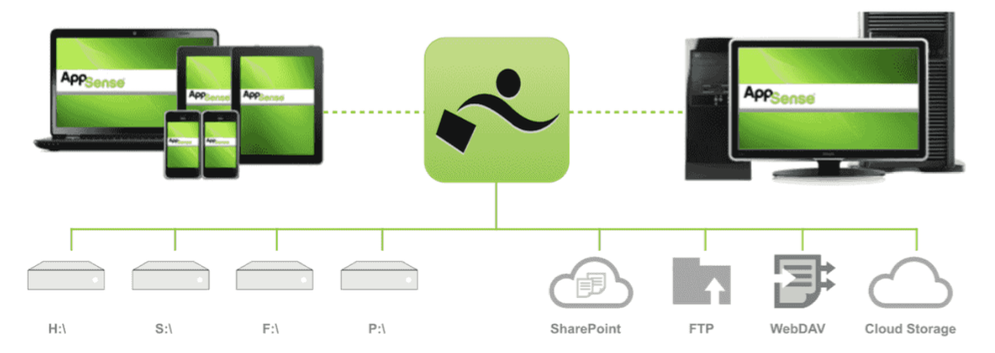DataNow to File Director: The Evolution
Should you consider any item on the list below a current or future challenge, then this blog is for you. Ivanti File Director delivers upon each of these use cases and much much more. Read on to discover how the product has evolved to get to the enterprise scale data management solution it is today:
- Managing the local desktop file data of your users throughout and beyond Windows 10 migration.
- Reduce laptop/desktop break-fix cost and effort
- Replace Microsoft Offline Files
- Unlock the 1TB of free OneDrive storage that every Office 365 user gets
- Files on demand for OneDrive on Windows Server
- Centrally manage and deliver both cloud and on-premises file data on-demand to physical and virtual devices, including Windows, Mac, iPad, iPhone and even Android
- Secure auditing of sync activity on both a global and per-user / per-machine level.
AppSense DataNow – A Brief History
Rewind seven years and AppSense is the market leader in user profile management with Environment Manager’s groundbreaking Personalization capabilities taking the market by storm (still is and still are). Accompany this with a rich, granular policy engine and administrators could control and personalize the user’s desktop and their settings from one centralized platform.
A personalized, responsive desktop is a great profile management story but only one chapter in the book of a productive end user. Applications and profiles are nothing without data and access to that data needs to be instant and readily available using a simple method familiar to the user. In order to complete the user settings + data management story AppSense introduced DataNow to its portfolio.
DataNow was released with a ‘DropBox for the Enterprise’ label. A method to securely share documents, across multiple platforms, was in demand following some very public failings of DropBox to securely store sensitive user information. Unlike the more consumer-centric services, DataNow offered organizations the ability to store the data in a private cloud within the enterprise's own IT environment using a virtual appliance created to enable the flow of data.
DataNow as an EFSS Solution:

DataNow adoption as an Enterprise File Synchronization and Share (EFSS) solution was slow and steady. There were questions over client stability and scalability, and it is fair to say the product had its fair share of challenges in its early days. Over time these challenges were understood and owned by our product teams, working closely with our vast array of enterprise customers to help satisfy the demands of an enterprise data management solution and meet the key use cases the market demands of us.
Ivanti File Director and the Roaming User
Fast forward to 2019 and the product to deliver upon these local file management use cases is now known as Ivanti File Director. No longer just a file sharing solution, File Director tackles all the data challenges facing a roaming user in a modern world.
Here is how File Director can help you roam users’ data seamlessly across devices and platforms. Ranging from Win 7 to Win 10 migrations over to RDSH and VDI session-hopping, File Director is your solution of choice:
File Director vs SMB File Shares

- A native, non-disruptive data capture and restore user experience.
The ‘In-Location-Sync’ feature ensures user files are synced to on-premises or cloud storage from within their current folders and locations. Files within a user’s existing profile are synced automatically from their current location, for example, from the Desktop, Documents, or Downloads without User Shell set redirection or file copies. The feature also ensures that applications work as before as the files are managed from within the locations they are hard-coded to read from.
At first logon to a new OS or refreshed device the files are restored exactly where they left them on the previous client. There is no digging around for files within secondary locations accessible via the system tray as is the case with other solutions.
- We Truly Sync ‘Files on Demand’ on any platform including RDSH on Windows Server 2016 and 2019, and Windows 7.
File Director has been delivering files manually, on-demand for years and we can support you on any modern OS be it single or multi-user, when employing this capability. With a manual Map Point configured, the end user will see file listings instantly appear at logon for all captured server data giving them the impression every file is available locally.
The files will then be synced on-demand as and when the user requires them. The user can manually override the sync options of any folder and can initiate the download and local caching for the duration of the session, if desired.
- Control which files sync based upon a granular sync policy exclusion engine.
Manage Sync activity on a per user or device basis. Exclusion criteria such as file type, size, age, path etc. are available. Administrators can also apply bandwidth control to sync activity ensuring logon storms and migrations are handled smoothly and not at the detriment of the wider network.
- You can finally replace Offline Files with a solution that works.
Not many will shed a tear at the prospect of moving away from Microsoft Offline files. Various design flaws around support for encrypted files, its ability to detect offline state and minimum permission set requirements mean it can not be relied upon to deliver and maintain offline access for remote workers. It also requires a VPN connection back to the file servers, and cannot work over a pure HTTPS web connection.
File Director integrates with existing file shares and environments transparently, utilizing current NTFS permissions, ensuring zero impact on data storage, redundancy and business continuity plans. File Director also provides industry standard encryption of data – both in-transit and at rest on mobile devices – for improved governance and compliance when storing files offline.
Low disk space? No problem, we clean up after ourselves.
File Director Cache Management can be configured to clean up the local copy of any file after it has been closed by the user. This can result in a truly on-demand experience and zero touch approach to local disk space. This feature can be hugely beneficial on low disk VDI and shared terminals where large numbers of sessions are caching data locally.
Central management of cloud and on-premises storage
Unlike other cloud-only solutions, File Director can be configured to manage access to cloud storage via one map point and on-premises storage to another, both within the same session. We also provide tools to help you seamlessly migrate user home drives from on-premises to cloud storage.
Secure environment auditing and health monitoring
File Director outputs a constant stream of syslog data from the server containing sync activity on a per user + device basis. This data can be analyzed and reported upon using 3rd party tools such as Splunk. Client data is also outputted to the local event log and can be centrally reported on from the Ivanti Management Center.
Choose File Director to unlock 1TB of free OneDrive storage
Challenges with Office365’s OneDrive cloud storage
Because OneDrive storage is provided to users – not IT – administrators lack the controls needed to view and manage its content. Accessing and using OneDrive typically requires changes to user working behavior. This typically requires user training and increases in helpdesk calls. Additionally, users employing multiple devices to do their work may find that they can’t access OneDrive from some of them.
Ivanti OneDrive Connector – Capture, control, and audit OneDrive
File Director’s OneDrive Connector solution allows IT to capture, control, and audit Office 365 users’ 1TB of OneDrive storage. The connector uses File Director’s granular sync engine and In-Location Sync capabilities to migrate user files smoothly to OneDrive cloud storage. However, as with on-premises storage, users’ everyday Windows experience when accessing files and folders is unaffected.
With File Director acting as an on-premises broker to OneDrive, IT has complete audit and visibility of how OneDrive storage is being used, while delivering a familiar user experience that feels just like using any other file server. No special folders, no clunky redirection, no endpoint device limitations.
File Director’s capabilities don’t end with the OneDrive Connector. Acting as a broker between the user workspace and cloud or on-premises storage, File Director makes data migration fast, secure, and invisible to the user.

The following table summarizes many of the capabilities described above. If you’d like to learn more you can read about File Director or speak with your partner or Ivanti account rep.
|
Key Capabilities |
File Director |
OneDrive For Business |
|
Flexible sync options on Server OS include background sync, real-time or ‘Files on Demand’ to cater for limited local disk resource or slow networks |
✔ |
✖ |
|
Local Cache Management – the ability to reduce the size of local endpoint file caches based on the last access time of files |
✔ |
✖ |
|
Secure Auditing for physical and virtual endpoints enables IT to quickly identify potential network or storage requirement issues |
✔ |
✖ |
|
Native User Profile ‘In-Location-Sync’ allow users to save files anywhere and have them synced centrally to eliminate data sprawl |
✔ |
✖ |
|
Hybrid SMB + Cloud Storage accessibility caters for organizations making a staggered or full move to the cloud |
✔ |
✖ |
|
OS Migration Tools & Dashboards for simplified administration and visibility of storage requirements |
✔ |
✖ |
|
Granular Bandwidth Control over pipe usage % and Kb/s caters for remote users with low bandwidth links |
✔ |
✖ |
|
Secure NTLM + Kerberos SSO support simplifies the end user experience whilst ensuring security |
✔ |
✖ |
|
Natively and globally map a drive to cloud, or local, storage enabling offline access to files for a mobile workforce. |
✔ |
✖ |
|
Ghost and placeholder files provide a searchable view of files, without having to first download files locally from cloud storage |
✔ |
✖ |
|
Exclude files from sync based upon file extension to reduce cloud or on-premises storage requirements |
✔ |
✔ |
|
Exclude files from Sync based upon size, age, type or path to provide targeted management of user data |
✔ |
✖ |
|
Exclusion override capabilities on a Per User > Per File Type or Path basis to cater tailored user environments |
✔ |
✖ |
|
Global sync status control (Admin pause) can be applied to assist with troubleshooting unexpected sync issues |
✔ |
✖ |
|
Special sync handling of PST files (SMB) utilizes delta sync and Integrity block checking methods to reduce network consumption |
✔ |
✖ |

